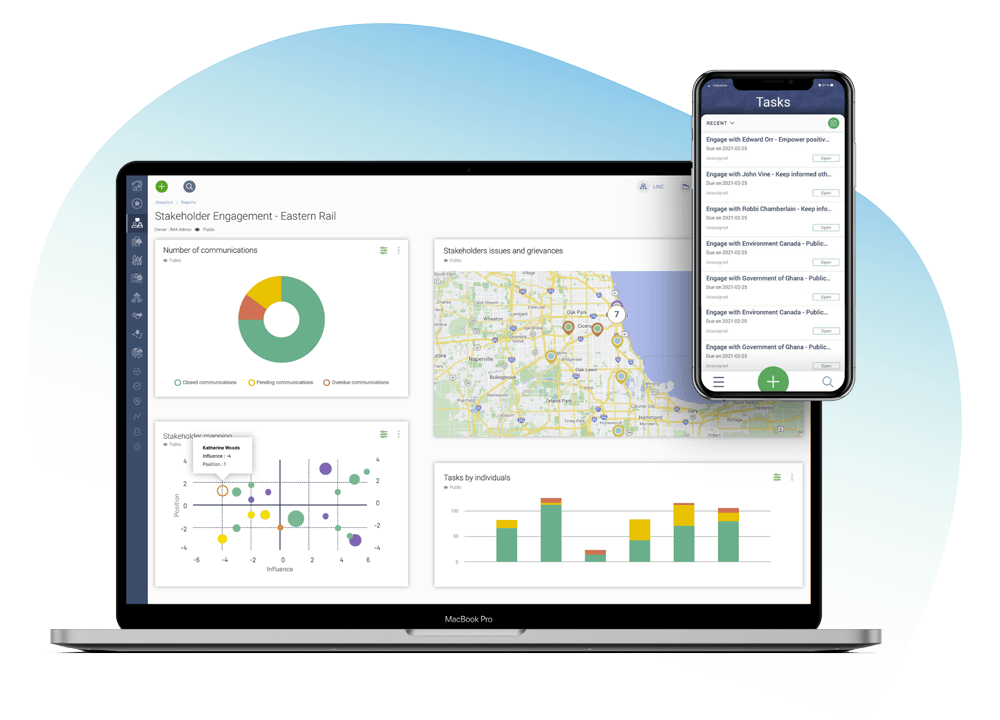Conflict and disagreement are a part of the human experience. On a complex project with multiple stakeholders, conflict is practically inevitable. Deal with grievances, conflicts and disagreements constructively, and you could find they’re an asset that allows you to see issues from a different perspective and problem-solve with new thinking. Fail to, and they could become a serious liability that creates havoc with project timelines and deliverables, damage relationships and reputations or block your initiative entirely.
How stakeholder conflicts arise
Conflicts and complaints within multi-stakeholder project environments don’t just erupt out of nowhere. Stakeholder conflicts may arise differently according to their types. First type of conflict may be task- or process-related and exacerbated by unclear roles and responsibilities, unreasonable or irrational expectations and competing interests. The second type refers to conflicts that are relationship-related and complicated by stakeholders’ differing communication styles, cultural history, overall comfort with change, and even level of emotional investment in the project. Finally, conflict can stem from diverging values. Value conflicts originate from deep-rooted differences in beliefs and principles, including political, religious, and ethical viewpoints.
How stakeholder conflict escalation affects problem-solving
Not all conflicts are problematic, and not all difficult stakeholders have the same level of opposition. But when communication breaks down, and groups resort to us-vs-them thinking or retreat into entrenched silos, conflict levels can go from productive to destructive in a heartbeat. In the face of increased hostility and polarization, creative problem-solving slides off the table entirely.
Conflict types and escalation levels to be mindful of include:
- Productive – In productive conflicts, participants understand a shared problem needs solving. Although they may disagree on how to address it, communication is respectful, group energy is positive, and there’s an openness to listening to different opinions and exploring new options.
- Personalized – When personal attacks start, communication can slowly grind to a halt and group cohesion may deteriorates. Even stakeholders not involved in the conflict can become demotivated and silenced. Some movement on low-level issues may still be happening, but it’s haphazard at best.
- Destructive – In destructive conflict, stakeholders appear to want to “win” versus problem-solve, and communication devolves into intensely personal criticisms or contemptuous arguments. Passive-aggressive stakeholders may stay silent but resort to obstruction or evasion behind the scenes.
- Hostile – Open verbal hostility, intimidation tactics and even project sabotage become possible at this level of escalation.
- Polarized – Emotions overwhelm stakeholders’ capacity for rational thinking. Stakeholders retreat to ideological silos and entrenched positions, and problem-solving comes to a standstill.
The benefits of conflict resolution
Effective stakeholder conflict resolution builds a culture of respect, fosters open communication and ultimately, creates trust. The result is increased stakeholder engagement and collaboration and the potential for new insights to surface and real problem-solving to occur.
Stakeholder analysis: Hoping for the best, preparing for the worst
Long before the project begins or even a single negative word is spoken, stakeholder analysis seeks to anticipate where conflicts might occur during the project’s planning, consultation and implementation phases, reflecting a more inclusive and continuous process spanning the entire project lifecycle.
Possible drivers of stakeholder conflicts
The sources of stakeholder conflicts can be multifaceted and complex, varying by context, industry, and the specific stakeholders involved. However, several common sources are frequently identified:
Differing objectives
Stakeholders often have different goals and objectives. For instance, a company may aim to maximize profits while local communities seek to preserve their environment and cultural heritage.
Resource competition
Environmental concerns
Economic disparities
Cultural and social impacts
Governance and decision-Making
Legal and regulatory issues
Health and safety concerns
Once possible sources of resistance or conflict among stakeholders are identified, project managers can develop communication and other engagement strategies to build trust, cooperation and collaboration.
A seven-step process for dealing with stakeholder conflicts
If conflicts still arise despite all your best efforts, try using the following seven-step process to resolve them.
1. Acknowledge the conflict
It might be tempting to pretend stakeholder conflict isn’t happening or that if you ignore it, it’ll resolve itself. Unfortunately, that’s usually not the case – and what’s more – when dismissed, conflicts can reappear at inopportune times or quickly escalate to destructive levels.
Addressing conflicts as soon as they occur allows you to diffuse potentially volatile situations and enables all parties to work toward a solution.
2. Gather information through open communication and active listening
You can’t resolve a conflict until you understand what’s causing it. And you can’t understand it until you hear all sides. In essence, you’re aiming to peel back the symptomatic layer (shouting and arguing) to expose the core of the problem that lies beneath.
To get as complete a picture of the problem as possible, you’ll want to schedule a meeting where the parties in conflict get to express their concerns openly and without interruption. As a project manager, your job is to listen with empathy and avoid assumptions and judgments.
If you need more clarification on an issue once a stakeholder has finished speaking, try asking open-ended questions (i.e., those that require a more detailed response versus just “yes” or “no” answers) and probe deeper until the specifics of the issue become clear. Next, you’ll want to repeat, paraphrase or summarize the answers you hear so stakeholders can confirm that you’ve captured their concerns accurately.
3. Analyze and prioritize the issues
4. Co-create and evaluate potential solutions or compromises
5. Negotiate and agree on a solution
Exploring solutions involves brainstorming ideas, weighing the pros and cons of each via a SWOT analysis and determining the resources, time and other elements needed to implement them. Negotiation involves stakeholders making concessions and planning for contingencies, putting together offers and counteroffers, and finally agreeing on a single solution or scoring a slate of solutions within a decision matrix to determine which solution to implement now, next, later, last or possibly not at all.
Navigating this process allows the stakeholders themselves to define what constitutes a “win-win” outcome for all while committing to continue working together in the future.
6. Implement the solution
7. Follow up and monitor the implementation
How can stakeholder relationship management software help mitigate stakeholder conflicts
Stakeholder relationship management (SRM) software equips project teams with the tools necessary to effectively manage and nurture relationships with stakeholders. Here is how it specifically helps in preventing conflicts:
Centralized information
A fit-for-purpose tool consolidates all stakeholder information, ensuring team members are equipped with up-to-date insights into stakeholder, sentiments, needs and expectations. This coordination helps in preempting misunderstandings that could lead to conflicts. Moreover, it contributes to braking information silos across the business. This can help consolidate across-the-board knowledge and understanding about an individual or a group of individuals.
Stakeholder mapping
By helping map stakeholder data, software helps teams understand various interest groups and anticipate their concerns. This foresight allows for addressing potential issues proactively, thereby averting possible confrontations.
Effective communication
An effective platform facilitates systematic outreach to stakeholders, ensuring that they are continuously engaged and their concerns are heard. Effective two-way communication nurtures trust and can resolve issues before they escalate.
Feedback mechanism
Implementing a robust feedback system within the software allows teams to capture stakeholder concerns or even grievances, track them, and act swiftly. Addressing feedback promptly can significantly reduce the chances of stakeholder dissatisfaction turning into conflict.
Issue resolution
Using an SRM software with complaint management capacities helps in logging and managing stakeholder issues, assigning tasks to team members to address them efficiently. Quick resolution of issues demonstrates to stakeholders that the organization values their input, thus maintaining harmonious relations.
Reporting and documentation
A good stakeholder management software will have robust analytics tools that can help generate reports on stakeholder engagement activities. This allows teams to review and adjust their strategies, ensuring a clear understanding of what approaches are effective in maintaining positive stakeholder relations and preventing disputes.
Strategic engagement plans
A good stakeholder management software enables the creation of personalized engagement strategies that respect the unique interests and values of different stakeholders. Tailored communication can mitigate the risk of misunderstandings and value-based conflicts.
Decision-making support
By providing detailed records of stakeholder preferences and past interactions, an advanced SRM supports informed decision-making that takes into account the potential impact on stakeholders, thus reducing the likelihood of contentious outcomes.

Find out how Borealis stakeholder engagement software helps a renewable energy company to strengthen stakeholder relationship management.





